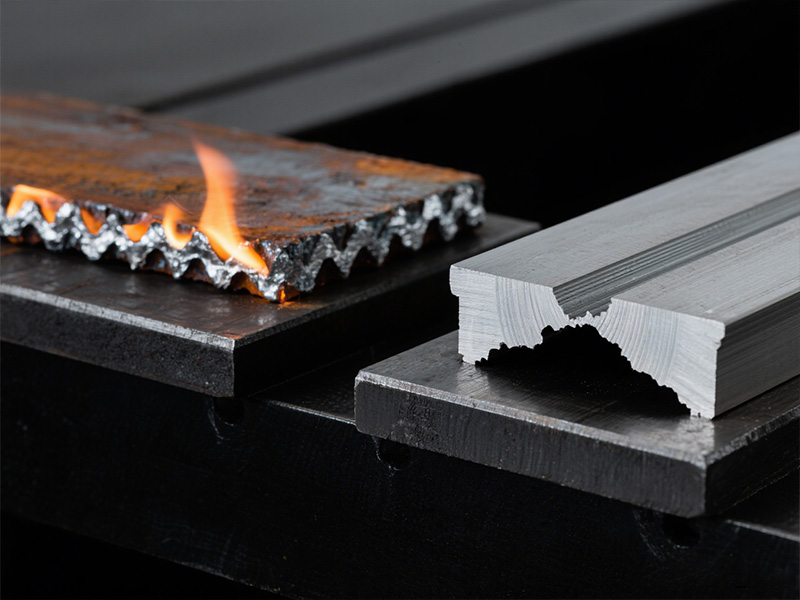-
 Call Now ! +86-13912367818
Call Now ! +86-13912367818 -
 Email Now info@wxhlhg.com
Email Now info@wxhlhg.com


Cutting technology was once a foundation for heavy industries such as shipbuilding, building steel structures, and making machinery. Manufacturers right now use contemporary metal cutting machinery for use with enormous steel plates and complex parts, as they need more speed and accuracy. The CNC flame cutting machine and the CNC plasma cutting machine are two of the most common choices.
This article looks at the variations between flame cutting and plasma cutting, what's they do in shipbuilding, and how they assist in up-to-date industrial metal fabrication.
A CNC flame cutting machine, referred to as CNC oxy-fuel cutting, cuts metals by heating oxygen and fuel gas, such as acetylene, propane, or natural gas.

This kind of thermal cutting is frequently used for constructing ships, heavy machinery, and structural steel, where very thick plates are common.
A CNC plasma cutting machine utilizes an electrical arc and under pressure gases such air, nitrogen, argon, or oxygen to create plasma that gets extremely powerful and can melt and cut through metal.

Commonly used for the construction of ships, cars, and industrial metal production, where medium-thick plates (1–60mm) are cut quickly and precisely.
More expensive instruments and higher energy bills.
Not good for steel that is very thick (in excess of 60 mm).
| Feature | CNC Flame Cutting Machine | CNC Plasma Cutting Machine |
| Cutting Principle | Oxygen + fuel gas combustion (thermal cutting process) | Ionized plasma arc (thermal cutting process) |
| Material Range | Carbon steel only | Carbon steel, stainless steel, aluminum, copper |
| Cutting Thickness | 50mm–300mm+ (very thick plates) | 1mm–60mm (thin to medium plates) |
| Cutting Speed | Relatively slow | Very fast (up to 10x faster) |
| Edge Quality | Rougher edge, more finishing needed | Smooth edges, less secondary work |
| Cost | Low equipment and operating costs | Higher equipment and operating costs |
| Industrial Use | Shipbuilding, heavy machinery, steel structure | Shipbuilding, automotive,and general metal fabrication |
This comparison highlights why many workshops and shipyards adopt both technologies for maximum efficiency.
One of the greatest consumers of metal cutting methods is the shipbuilding industry. It is essential to cut hull plates, decks, bulkheads, and internal structures perfectly for every vessel.
An excellent instrument for cutting challenging hull plates and base structures, which have to be durable and remain.
Excellent for cutting stainless steel components, piping systems, and plates that are medium-thick.
Shipyards may be more efficient, accomplish less rework, and keep the degree of accuracy required for current vessels by using the two methods in tandem.
Both machines are used a lot in industrial metal fabrication areas like construction, energy, and heavy machinery, as well as for building vessels.
Flame cutting is a cheap way to cut enormous structures like beams and columns.
For making parts for machines, panels, and assemblies fast and with a clean finish, plasma cutting is the best technique.
These technologies are a vital component of the thermal cutting process for companies because rapidity and precision are what keep them competitive.
Many manufacturers use both methods instead of just one for maximum flexibility:
Flame cutting for carbon steel which is very thick.
Plasma cutting provides the ability to process thin to medium plates faster and with better quality.
This combination keeps costs down while meeting the needs of varied materials.
It is evident that both flame cutting and plasma cutting have their own benefits when you evaluate them together. For shipbuilding and heavy industry, the CNC flame cutting machine is an excellent solution for very thick carbon steel. Conversely, the CNC plasma cutting machine is fast, adaptable, and precise for a wide range of metals utilized in industrial metal manufacturing.
Most manufacturers would be more successful via both systems at the exact same time. This helps to make sure that every thermal cutting procedure is as versatile as possible, rescues cash, and gets great results. These two cutting technologies remain at the heart of contemporary metal cutting technology as long as companies around the globe desire speed and precision.
A CNC flame cutting machine cuts very thick carbon steel using oxygen and fuel gas. A CNC plasma cutting machine cuts a wider range of metals faster with an ionized plasma arc.
A CNC flame cutting machine is better for hull plates that are quite thick. A CNC plasma cutting machine works better for plates that are medium-thick and parts made of stainless steel.
Not all the way. Plasma cutting is faster and more flexible, but flame cutting is still the best way to cut very thick steel plates at the lowest cost.
Most of the time, CNC flame cutting machines cut carbon steel. They don't work well with aluminum or stainless steel.
Yes. Flame cutting and plasma cutting are both thermal cutting processes that use heat to melt and cut metal.
CNC flame cutting costs less for equipment and running costs, whereas CNC plasma cutting costs more for equipment and running expenses, but makes edges faster and better quality.
Leave a Reply